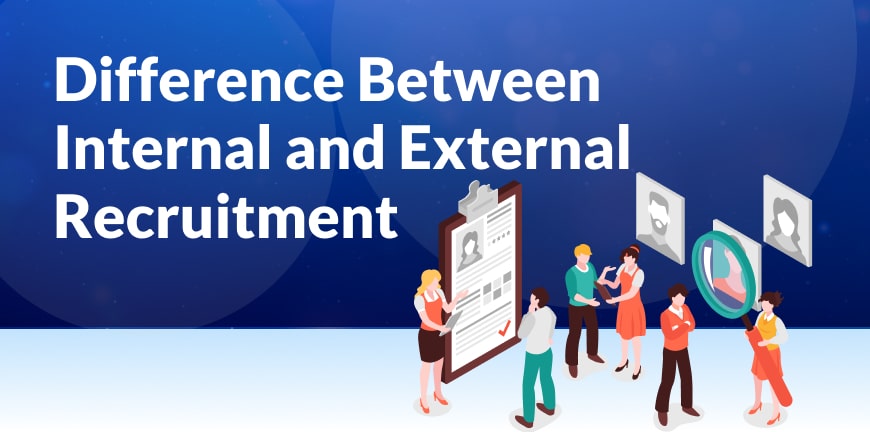
Employee Compensation Plan – A Complete Guide for Employers
02/06/2025
8 Tips for Effective Communication in the Workplace [2025]
03/06/2025- Introduction
- What is Internal Recruitment?
- What is External Recruitment?
- Key Differences Between Internal and External Recruitment
- When To Use Internal Recruitment?
- When to Use External Recruitment?
- Best Practices for Combining Internal and External Recruitment
- Are You Looking for a Recruitment Partner?
- Frequently Asked Questions (FAQs)
Introduction
“Recruiting the right talent”, are phrase that surrounds every organization, and decides their trajectory of success. But the job market hasn’t been very kind to recruiters. Finding the right talent, regardless of the kind of recruitment method used, has been challenging. Two ways to go about recruiting are internal and external recruitment methods. But to know how to reap the best out of it, you must know about the differences between internal and external recruitment, how they will benefit your firm, and which method to use when.
What is Internal Recruitment?
Internal recruitment refers to transferring or promoting potential employees within the organization to fill the open positions. Employees within the organization can either be employees who are currently employed or ex-employees who have left the organization but want to voluntarily return.
Employees who are internally recruited for the open position mostly move to higher positions. Some of the common internal recruitment methods are- advertising internally, promoting existing employees, transferring employees from one department to another, re-employment of ex-employees, and more.
What is External Recruitment?
External Recruitment refers to recruiting fresh employees from outside the organization. This includes both passive and active candidates. This process is time-consuming as you have to go through the entire recruitment process. At times, there is also a risk where you can’t ensure the best fit as there are various parameters to consider, including skills, abilities, and experience. Some of the common external recruitment methods are- campus recruitment, job consultancies, references and recommendations, newspaper ads, job portals, fairs, seminars, and references.
Key Differences Between Internal and External Recruitment
| Internal Recruitment | External Recruitment | |
| Source | Employees from within the organization are recruited and transferred, or promoted to new open positions | Employees are recruited from outside the organization through headhunting. |
| Induction | Employees do not need induction training as they are existing employees and are well-versed with the operations | Induction training is required as they are new, fresh employees who are recruited from outside the organization. |
| Speed of recruitment | Recruitment is much faster as it happens from within, and employees are already employed within the firm. | It is slower as it involves all recruitment stages like advertising, screening, selection, training, and induction. |
| Basis | Employees are recruited based on merit cum seniority level | Employees are recruited based on their skills as well as qualifications |
| Cost | It is a cost-effective process as there is no need to spend on advertising and other aspects of recruiting externally | A significant amount of money is spent on advertising, background checks, and more. |
| Scope | The scope to recruit fresh talent is limited, as the selection happens from within the organization | The scope of recruiting skilled, fresh talent is higher as outside candidates are recruited. |
When To Use Internal Recruitment?
Internal Recruitment method is the one to go for when organizations are pressed for time and are looking to hire and fill positions quickly. Some of the considerations for internal recruitment are-
1. Looking to hire swiftly
If you are looking to fill the open positions in your organization quickly without delay, then opting for internal recruitment is better, as you don’t have to do the headhunting part and go through the traditional recruitment process; instead, recruit from within, conducting a shorter interview process and leaving out the background check process, as they are already employed within your organization.
2. When working on a tight budget
By hiring from within your organization, you reduce the costs spent on the recruitment process, which could include paying for job boards to post your job opening listings, by paying media companies. You can instead share your requirement through company emails and newsletters.
3. Want higher engagement of employees
By hiring internally, you are essentially interacting with employees who are already working within your organization, who understand your company culture, and are doing well in their roles. By promoting these employees, not only will you be showing your commitment towards them, but it will also lead to higher engagement.
4. Reduce performance risks
Hiring from within the company allows you to access all the information about the candidates. You can review the candidate’s performance so far and even have a word with their co-workers to gain better insight into their nature and fit for the role. This ensures reduced risk of bad performance.
When to Use External Recruitment?
If you are looking to hire candidates who can bring in new, innovative, and fresh perspectives, then external recruitment makes sense. Hiring from outside can also bring in skills that you are in dire need of, without you having to spend on training
1. Expanding talent pool
If you are looking to expand your talent pool, then external recruiting is good as you gain access to talent outside of your organization with the experience and skills you require to fill the open positions.
2. Fresh perspective
Recruiting outside talent can help bring in fresh perspectives and ideas that could stimulate and boost the productivity of your organization, which may not happen if you hire internally, as these employees are comfortable in their positions.
3. Diverse pool of talent
When you wish to have a diverse pool of employees work for you, external recruitment is better. Through this method, you get to come across and interview candidates from diverse backgrounds, have unique experiences.
Best Practices for Combining Internal and External Recruitment
Combining the two approaches to get the best out of them requires a strategic move. Some of the best practices to combine the two for the best recruitment outcomes are –
- Making sure the job openings are communicated clearly by providing transparency and including details about the process, like eligibility, criteria, and more.
- Ensure that your selection process is free of bias and is purely based on skills and other important criteria.
- Incorporate a culture in the company that encourages employee development, and include training programs and more
- Use employee referrals to gain access to networks of candidates who may just be the next best fit for your company.
- Identify potential internal candidates and implement succession planning strategies to ensure a constant talent pipeline.
- Whether you’re recruiting internally or externally, you must make sure that your candidates know your decision and why it was in their favor or not.
- Make sure to assess whether your internal and external recruitment methods are working well for your organisation or not.
Are You Looking for a Recruitment Partner?
You can’t really tell which type of recruitment is better for your organization, as both have their own pros and cons, and depending on the situation, both recruitment methods may work. But how do you decide which is best for you? With the help of a recruitment partner like Alp Consulting! Our expertise in the industry and our expert recruitment partners carefully assess your needs and come up with a plan that will ensure the recruitment of the best candidates for your open positions.
Frequently Asked Questions (FAQs)
1. What is the difference between internal and external recruitment?
As the name suggests, internal recruitment means hiring from inside, meaning promoting or transferring a present employee to another position. External recruitment means recruiting candidates from outside the organisation who can bring in fresh perspectives.
2. Which recruitment method is faster?
The internal recruitment method is much faster, as there is no need to go through the extensive recruitment process that involves various steps before recruiting the right candidates. Here, you recruit from within and transfer or promote existing employees to higher positions.
3. When should a company prefer external recruitment?
A company must prefer external recruitment if it is looking for the following: fresh ideas and innovative perspectives, a wider talent pool, access to special skills, filling skill gaps, better diversity in the workplace, and having a competitive advantage.
4. Does internal recruitment improve employee morale?
Recruiting employees internally makes employees feel like they are valued and also shows the organization’s commitment towards them. This not only helps empower the brand but also boosts employee morale.
5. What are the advantages and disadvantages of internal recruitment?
Every recruitment method comes with its pros and cons, and the same goes for internal recruitment. While it’s a great way to save time and resources on recruitment as well as hire someone well-versed with the company culture, it is also associated with certain disadvantages, like making the other employees think the decision was unfair, not being able to bring in new candidates with fresh ideas, etc.
6. How does external recruitment benefit a company?
External recruitment can benefit a company in a number of ways, including providing companies with access to a wide pool of talent, offering a fresh perspective, increasing efficiency, getting the best out of employee referrals, reducing employee tension, and establishing authority.
Contact Us For Business Enquiry

Amit Saproo
Amit Saproo is the Head of Operations at ALP Consulting with nearly 17 years of experience in Executive Search, RPO, Leadership, and IT & Engineering recruitment. He leads nationwide recruitment programs across Technology, BFSI, and R&D domains, driving strategic hiring solutions for diverse client needs. Amit excels in building and managing high-performance teams that deliver scalable, end-to-end recruitment and consulting services.




